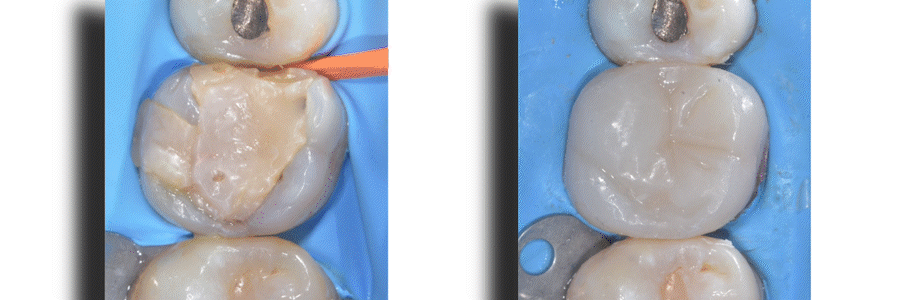Is Biomimetic Dentistry Worth It?
Despite having a scientific foundation from research that is four decades old, biomimetic dentistry, also known as biomimetic restorative dentistry, may seem new to many doctors and patients. So the question will arise, “Is biomimetic dentistry worth it?” This is a decision every doctor and patient should make for themself, so let’s explore some sides to this question.
Biomimetic restorative dentistry gives vital teeth with deep caries like this one a chance to heal. Case by Dr. Davey Alleman, DMD.
Is it time for the dental industry to try something “new”?
Traditional dentistry today looks similar to the dentistry performed 100 years ago. Yes, we can x-ray teeth and offer anesthesia, but the same mechanical retention fillings that G. V. Black pioneered over 100 years ago are still considered the standard today.
While composite might match a tooth’s color, without proper bonding, as seen in this case, it offers little advantage over a traditional retention form restoration.
Research in adhesive dentistry, which has grown into biomimetic dentistry, began 40 years ago as scientists studied how to consistently detect and remove decay in teeth, how to bond to different areas of the tooth and how to seal a tooth’s nerve to protect it from further cracks and decay.
Consider cars, plumbing, healthcare, technology of the 1920’s, the 1980’s and today. Biomimetic dentistry is not new. Doctors and patients have seen its successes in 1,000s of clinical cases over the past 20 years since Dr. David Alleman began consolidating this research in a way that doctors all over the world could learn and practice for their own patients. While there is a wealth of evidence as to the effectiveness of biomimetic dentistry, there are more points doctors and patients should consider.
Learn more about Dr. David Alleman’s research into better dental protocols in his Six Lessons Approach Podcast episode.
Is biomimetic dentistry worth the additional training?
Biomimetic dentistry is not a specialty like endodontics or periodontics, but it still requires a high level of training to practice. It can be applied to nearly all general and specialty fields to conserve tooth structure and minimize the risk of future retreatment.
Biomimetic dentistry uses techniques that achieve a stronger bond between what remains of the healthy natural tooth and the composites that rebuild it. This requires extensive training and dedication from doctors so they can offer this level of expertise to their patients. Only a few dental schools in the world train students to the level where they can practice biomimetic dentistry effectively upon graduation, so doctors who train in biomimetic dentistry do so because they feel that being able to treat teeth with predictable biomimetic outcomes is worth the investment.
The steps in a biomimetic restoration are not easier, but these advanced techniques offer superior results compared to traditional restorations.
For patients: Is a doctor who is using newly learned biomimetic techniques less skilled than a doctor who has been performing traditional amalgams and fillings for years? No. Doctors trained at the Alleman Center learn a system of protocols to address cases from the everyday to the unique and challenging. They will know how to address your needs because they have an in-depth understanding of the research that guides how they more effectively treat a tooth. Traditional techniques rely on old research and inexact protocols, which often lead to symptomatic outcomes that require more treatment for the patient overall.
View our world-wide alumni of Alleman Center training programs below:
Is biomimetic dentistry worth the cost?
This is something doctors and patients should be asking themselves before every treatment, biomimetic or not. A traditional crown now will likely need further retreatment down the road, meaning root canal therapy, implants or dentures. Based on current clinical data, biomimetic restorations are staying intact and symptom-free for 20+ years. Once a lifetime of treatment is taken into account, which really costs more?
Learn more about how much biomimetic dentistry costs.
This case shows how a traditional crown does not protect the remaining tooth structure from further damage or decay. In addition to cutting the tooth to a standard shape regardless of existing pathologies, the tooth is left exposed and will likely need retreatment in the future.
As an example: You have a car, bike, appliance, etc. and could pay for a repair that is less expensive and should fix the problem for two to four years or for a repair that is more expensive but, based on current data, could be a permanent, one-time fix. Which would you choose? When the repair in question involves your lifelong health, does that make it easier to invest in a long-term solution?
Biomimetic dentistry uses the most advanced adhesive materials that manufacturers offer, which are used specifically because the adhesives perform well in independent studies rather than just based on manufacturers claims. Doctors who offer biomimetic dentistry use these advanced materials, but they are more expensive to purchase than standard filling material or crowns. So doctors have to decide if they are able to manage the extra cost of supplies in order to deliver the best care to their patients without it affecting other aspects of their business. If your doctor offers biomimetic dentistry, it is because they think the additional cost is worth the benefit to their patients.
This example of a biomimetic restoration by Dr. Davey Alleman, DMD shows how biomimetic dentistry conserves healthy tooth structure by adapting the restoration to the pathologies. Superior bonding protocols seal the healthy tooth structure, eliminating post-operative sensitivity and creating restorations that have been shown to last over 20 years.
For patients: The choice is up to you. We want to give you the tools to make the best decision for your oral health. Insurance companies have been slow to accept biomimetic restorations within their coverage, so biomimetic restorations may mean an out-of-pocket expense for patients. But for patients who have already experienced years or decades of recurrent treatment, tooth loss, endodontic treatment and restoration failure, having their tooth stay bonded and healthy could be the answer they are looking for.
Why do biomimetic restorations take more time?
We have already talked about the time doctors devote to their training to be able to practice biomimetic dentistry for their patients. But time is also a key ingredient in a successful biomimetic restoration. Strong bonds take time to develop, so the incremental layering and light-curing involved in restoring a tooth takes longer than the cookie cutter approach of traditional crowns and fillings. These strong bonds are what seal your tooth against bacteria, support the structure of the tooth to prevent cracks and ensure the restoration lasts for years, if not decades.
A longer treatment time means doctors often see fewer patients each day but still end up being able to help more patients overall. Those patients experience less recurrent decay, failed crowns and fillings or symptomatic teeth, which means they don’t need to come in for procedures as often.
Biomimetic dentistry takes more time because it addresses the complex needs of each tooth on a case-by-case basis. In this case example by Dr. Davey Alleman, DMD, a traditional approach would have likely recommended these teeth for crowns, root canal therapy and crown lengthening surgery.
Instead, they were treated using biomimetic dentistry: treating caries and cracks, isolating to improve bond strength, performing deep margin elevation to prevent crown lengthening surgery, using stress reduction techniques to increase the bond to dentin and protect the pulps of these teeth, then replacing the enamel in a way that allows them to function like a natural tooth. There is a high likelihood that these teeth will never need treatment again.
For patients: Your appointment will take a little longer but for a better result. Continuing education companies often market to dentists “Cut a Crown in 30 Minutes or Less” or “How To Offer More Root Canal Treatments in a Day.” Compare this with doctors trained at the Alleman Center, who take the time to diagnose the cause of symptoms, fully treat those causes and restore the tooth so it will remain bonded and symptom-free, and decide if you think the time is worth it.
For doctors deciding whether or not offering biomimetic dentistry at their practice is worth it, they are debating between offering what has always been done or offering the best.
For patients deciding whether or not biomimetic dentistry is worth it, they should understand the cost and benefits of traditional dentistry and biomimetic dentistry before making their decision.
Do you have questions about biomimetic dentistry? Reach out at info@allemancenter.com.
























